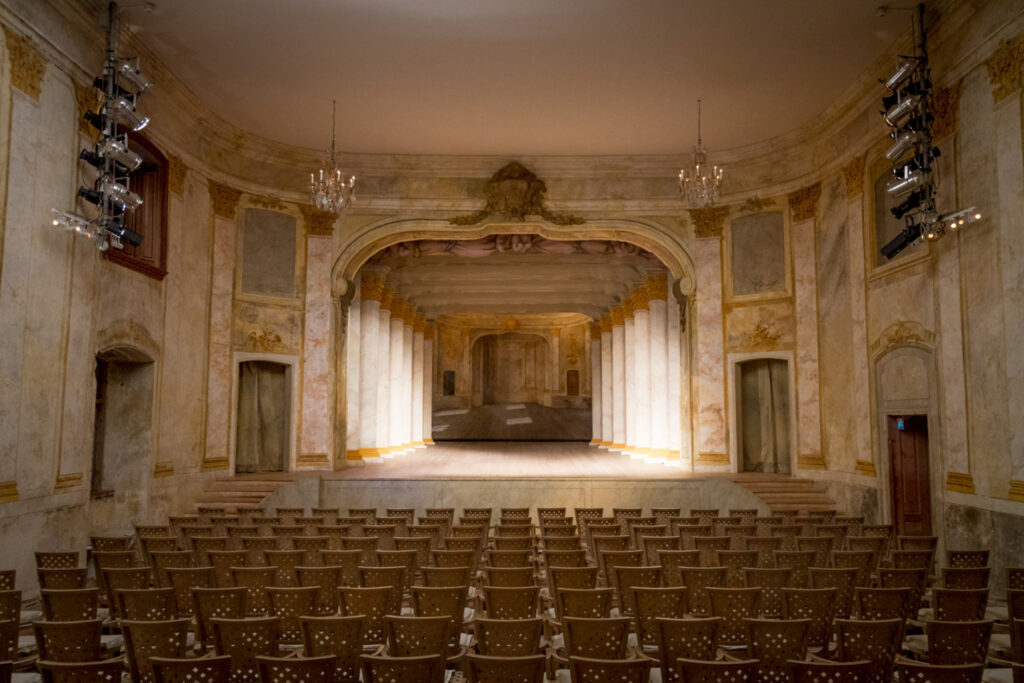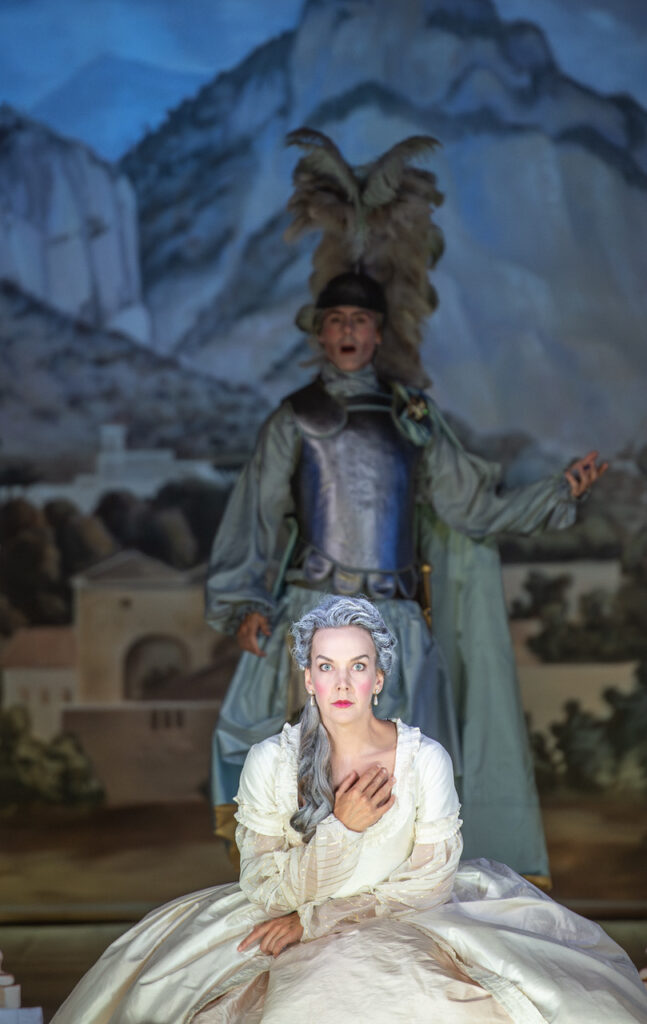Opera Director & Designer
Dardanus
Jean-Philippe Rameau (1683–1764)
Dardanus occupies a special place among the operas of Rameau, the most important French composer of the eighteenth century. In 1739, after the triumphs of Les Indes Galantes, Hippolyte et Aricie, Castor et Pollux and les Fêtes d’Hébé, the fifth of Rameau’s operas was initially performed unsuccessfully at the Paris Opera. The second version in 1744 became a great success. Gilbert Blin staged Dardanus for the 2023 Confidencen Opera & Music Festival.
Opera & Music Festival
Confidencen Ulriksdal Slottsteater, Stockholm
Opening July 27, 2023
Artists
Peter Spissky, Musical Director
Gilbert Blin, Stage Director
Christer Nilsson, Set Design
Karin Modigh, Choreography
Anna Kjellsdotter, Costume Design
Sofie Anderson, Light Design
History of Dardanus
Article for the publication of the Friends Association of Confidencen
Initial libretto
The librettist Charles-Antoine Le Clerc de la Bruère (1716–1754) worked closely with Rameau to make Dardanus more coherent than his initial libretto. They maintained what made the lyrical poem so unique: tragedy mixed with the ballet and the dramatic discontinuity as a result. In this sense, and according to these criteria, one can consider the librettos of Rameau’s Dardanus as an example of “theatrical” literature, as a pre-text for a spectacle on the stage. Replaced in its period performing context, this work may regain its intrinsic value of a spectacle.
Second version
Therefore, it may not be surprising to know that it is only in 1744, in its second version, that the work of Le Clerc de la Bruère and Rameau found its achievement. Later in the 1760’s, Rameau’s fame was at its pick and the work was presented many times at the Paris Opera. In October 1763, Rameau’s Dardanus was revived at the Château de Fontainebleau, royal residence during the autumn months. This production is the perfect source for our historically informed project for Confidencen. The first period of activities in Confidencen dates from 1753 and have a lot in common with the court theatre of Fontainebleau, refurnished the same year. But contrary to popular belief, the means for a royal production were not necessarily in relation with the ambition of their wealthy patrons, and archive reveals a real concern for optimizing resources both material and financial for this Fontainebleau production. Reality forms a dialog with artistic vision, and it is this relation leading to the stage illusion that we wish to explore in 2023.
Remaining visual aspects
The production of Dardanus in 1763 was prepared with great care and sources documenting it constitute one of the most complete records of the performance of a Rameau opera during the composer’s lifetime. The iconography includes plans and cross sections of the stage, drawings of costumes, and watercolors of the sets for the prison scene. Next to the score and the libretto, this pictorial data is giving us an excellent starting point to imagine our own sets and costumes. Besides giving a general idea of the strongly ordered visual aspect of an opera performance in France around the middle of the eighteenth century, these documents reflect the choices happening during the preparation of the performance and tell us a lot about the process and its categories. For the Confidencen production, we are taking inspiration from all this evidence but also how its elements relate to each other’s.
 Confidencen Theatre, stage proscenium, photo Confidencen
Confidencen Theatre, stage proscenium, photo Confidencen
Historical reviews
Archival documents include raving press commentaries published in Mercure de France which reports: “it would be impossible to imagine more magnificence & more brilliance in the costumes and in the sets”. The diary of Papillon de La Ferté (1727-1794), the administrator of the “Menus Plaisirs du Roi”, the royal household responsible for court ceremonies and entertainments, contains a more nuanced report of the process of producing Rameau’s masterpiece. A manuscript titled Programme de Dardanus Opera representé devant leurs Majestés Le 8 Octobre 1763 à fontainebleau, maybe from his own hand, presents for each act and character, the full list of the sceneries and elements of dress and garments planned. The system of this plan reveals the pragmatic company culture of the Paris Opera at the time. These documents are unvaluable to understand how a performance of an opera by Rameau was conceived and executed during the musician’s period: the constant concern for economy, both in saving and investing, is both humbling and inspiring.
Costumes and sources
The costumes were designed by the prolific “dessinateur des habits” of the Paris Opera, Louis-René Boquet (1717–1814). Some were made new, but the stock of the “Menus-Plaisirs du Roi” was used extensively. Boquet drew costumes where additional fabrics, mostly drape-garments in striped taffetas, were used to identify the Phrygian people and contrasted colors to characterize the principals. Anna-Kjelldotter, Confidencen Costume designer, investigates Boquet sketches but follows the same process: besides new costumes, various stocks of stage costumes are being reused and repurposed. As we have full descriptions by Boquet of fabrics used and their various colors, reactive to candlelight, choices for Confidencen are made following these guidelines but also must reflect a rigorous dramaturgy which is first built on our reduced groups of singing and dancing characters.
Sets
During the rehearsals of 1763, the sets were an object of interest and the “amateurs” made visits to the workshops where they judged the scenery to be “very beautiful, especially the one of the Prison”. This set, which is fundamental for the pathos of Dardanus, had to be made anew, as the stock of repertoire decoration of the “Menus Plaisirs” did not have one of this rare kind suitable for the size of Fontainebleau theater. The set for the Paris opera production of 1760, inspired by Piranesi, was still in the memories of the audience but too large for this court theater. Happily, we have some of the designs of Michel-Ange Slodtz (1705–1764), the royal architect, for this new prison set of 1763.
Christer Nilsson, Set master of Confidencen, has been choosing various pieces of scenery in a style close to the ones used in Fontainebleau. Many “changements à vue” of sets and movements of a flying cloud machine are needed for performing Dardanus: the machinery of Confidencen, expertly restored, will be put to good use to balance, with its mechanical motions, the stylized body language of singers and dancers.
With all these directions and Confidencen in mind, we hope that we can say in 2023, as it was when this Fontainebleau production was revived one more time in 1769, “Dardanus, the easiest and least expensive work to perform, having in stock most of the necessary things, […] was very beautiful by the magnificence of the decorations and the richness of the clothes.”
Gilbert Blin
Important links
Get in touch
Copyright
© 2024 Gilbert Blin, All rights reserved



